Rockets, genomes and particle accelerators Understand article
Science in School is published by EIROforum, a collaboration of research organisations. Eleanor Hayes, Editor-in-Chief of Science in School, reviews some of the latest news from the EIROforum members.
EIROforum

EIROforum, the publisher of Science in School, is a partnership of eight European inter-governmental scientific research organisations (EIROs). As regular readers of Science in School will know, the range of research done at these organisations varies widely – from molecular biology to astronomy, from fusion energy to space science. The equipment is also very disparate – including enormous particle accelerators, beams of neutrons or high-energy X-rays, large telescopes or the International Space Station.
Whether individually or as part of EIROforum, the EIROs are also involved in many outreach and education activities – for school students, teachers and the general public. Science in School is one example of a joint EIROforum activity; this article details other research and outreach activities at some of the EIROs.
To learn more about EIROforum, see: www.eiroforum.org
CERN: visit the world’s largest particle physics laboratory
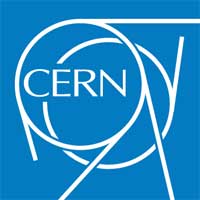
In 2010, a stunning 58 000 people visited CERN in Geneva, Switzerland. The permanent exhibition entitled ‘The Universe of particles’ attracts many visitors, offering them an overview of CERN’s research goals, tools and impact throughout the world. After that, many visitors go on to find out more about the research at CERN, visiting the control centre, the computer centre and SM18, a large hall housing cross-sections of the magnets used in the Large Hadron Collider (LHC), some superconducting cables and a life-size model of a section of the LHC tunnel.

‘The Universe of particles’ at
CERN. Click to enlarge image
Image courtesy of Michael
Jungblut / CERN
By the end of 2012, CERN plans to make the experience yet more spectacular for its visitors, with an even more realistic model of the LHC tunnel, plus high-tech audiovisual tools to make the roles of the control centre and computer centre clearer.
Why not apply to visit CERN with your students (aged 12 and over)? For more details, see: http://outreach.web.cern.ch/outreach/visites
The CERN education website offers information about all the teacher programmes, as well as educational resources for schools. See: http://education.web.cern.ch/education/Welcome.html
To find out more about the world’s largest and most powerful particle accelerator, the Large Hadron Collider at CERN, see:
Landua R, Rau M (2008) The LHC: a step closer to the Big Bang. Science in School 10: 26-33.
and
Landua R (2010) The LHC: a look inside. Science in School 10: 34-45.
To learn more about CERN, see: www.cern.ch
EFDA-JET: powered by humans

The young fusion scientists working at EFDA-JET in Culham, UK, make every effort to get the message about their research out to you, the public. In addition to their ‘day jobs’ in the lab, many are keen and happy to undertake outreach and education work.
A group of them recently gave up their Saturday to join the very popular opening event of the annual Oxfordshire Science Festival, explaining why fusion research is so important in the context of energy for the future of the world.
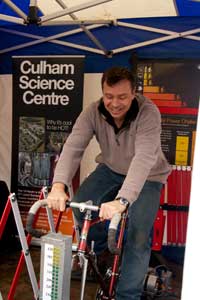
faces the ‘pedal power
challenge’
Image courtesy of Mel
Cunningham
This involved a ‘pedal power challenge’ to find out how hard you have to pedal a static bicycle to produce enough energy for lighting up even a single light bulb (15 Watt). There were plenty of volunteers who wanted to test their own energy and stamina at the fusion stand, as it is obviously easier to relate to explanations of the global energy challenge in terms of an individual’s energy needs.
Why not visit EFDA-JET and its scientists yourself? The Culham Centre for Fusion Energy runs special tours of the facilities as well as offering Open Evenings and running a great outreach programme including the ‘Sun Dome’, an exciting science roadshow for school students aged 10-12.
For more information on the outreach programme and to visit EFDA-JET, see: www.ccfe.ac.uk
To find out more about the annual Oxfordshire Science Festival, see: www.oxfordshiresciencefestival.co.uk
To build your own human powered bicycle generator, see:
http://scienceshareware.com/bike_gen.htm
www.instructables.com/id/Bike-Generator
www.magnificentrevolution.org/diy/single-bike-generator
If you prefer an energy bike for hire to come to your school, try Global Action Plan UK. See: www.globalactionplan.org.uk/energy-bike
To learn more about EFDA-JET, see: www.jet.efda.org
EMBL on air: ten years of the human genome

It was a global endeavour to rival the space race: billions of dollars invested, a massive international effort of singular scientific, medical, industrial and societal significance. The nail-bitingly close and bitterly fought battle culminated in the publication on 15 and 16 February 2001 of two scientific papers, one in Nature and the other in Science, of the first draft sequence of the human genome.
To celebrate ten years since the publication of the sequence, the European Molecular Biology Laboratory (EMBL) released a podcast describing what the breakthrough has meant for EMBL science and scientists. “The human genome sequence provided a blueprint of all the protein-coding genes in the human genome for the first time,” explains one EMBL scientist, Jan Ellenberg. “This changed how we go about studying protein function.”
The second in a new online series aimed at the general public, this podcast is complemented by a written article and visuals. To view the growing collection, see: www.embl.de/aboutus/communication_outreach/explore
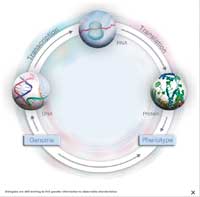
link genetic information to
observable characteristics.
Click to enlarge image
Image courtesy of Petra
Riedinger / EMBL
See the original 2001 research papers:
International Human Genome Sequencing Consortium (2001) Human genome. Nature 409: 860-921. doi: 10.1038/35057062
Download the article free of charge below, or subscribe to Nature today: www.nature.com/subscribe
Venter JC et al. (2001) The sequence of the human genome. Science 291: 1304-1351. doi: 10.1126/science.1058040
To learn more about EMBL, see: www.embl.org
ESA

When you think of the European Space Agency (ESA), do you fantasise about being an astronaut or consider ESA’s wide range of research and technology development? Did you know that, with the help of partners in Belgium, Ireland, the Netherlands, Norway and the UK, ESA also offers training sessions and conferences for primary- and secondary-school teachers? Through the European Space Education Resource Offices (ESEROs) in these countries, ESA also provides teachers with free materials for teaching space science and astronomy, and develops resources to meet the needs of the national education communities.
Founded in 2006, ESERO Belgium is a collaboration between ESA and the Belgian Federal Science Policy Office, based in Brussels at the Planetarium of the Royal Observatory of Belgium. In cooperation with colleges in Flanders and Brussels, it offers weekly workshops for trainee teachers on how to teach children about space and astronomy. The young teachers work together to make and launch rockets fuelled by vinegar and baking powder, build a lunar landscape out of plaster or use paper to build a model of the Solar System. They use quizzes and games to help the children to learn and remember. Many of the participants are amazed at how much fun – and how easy – teaching about space can be.
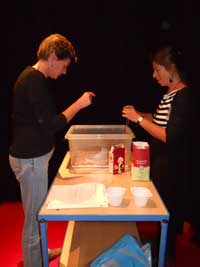
formed? Let’s find out!
Image courtesy of Ellen
Geerts, ESERO Belgium
At public events like Greenlight for Girls days, the ESERO activities are popular with children, who enjoy launching water rockets or making comets out of dry ice, starch, soil, water and window cleaner. In the future, ESERO Belgium hopes to extend its workshops to secondary-school trainee teachers.
For information about all the ESEROs, see: www.esa.int/esero
Greenlight for Girls encourages girls of all ages to consider a future in maths, science, engineering and technology by introducing them to the world of science in fun and exciting ways. To find out more, see: www.greenlightforgirls.org
To learn more about the European Space Agency, see: www.esa.int
ESO: planet formation in action?

Planets form from the discs of material around young stars, but the transition from dust disc to planetary system is rapid, and few objects have been detected during this phase. One such object is T Chamaeleontis (T Cha), a faint star in the small southern constellation of Chamaeleon that is comparable to the Sun, but very near the beginning of its life (the Sun is about half-way through its life). T Cha lies about 350 light-years from Earth and is only about seven million years old.
After careful analysis with the Very Large Telescope of the European Southern Observatory (ESO), a group of astronomers found the clear signature of an object located within a gap in the dust disc, about one billion kilometres from the star – slightly further out than Jupiter is within our Solar System and close to the outer edge of the gap. This is the first detection of an object much smaller than a star within a gap in the planet-forming dust disc around a young star. The evidence suggests that the companion object cannot be a normal star, but it could be either a brown dwarf surrounded by dust or, most excitingly, a recently formed planet.

shows the disc around the
young star T Cha. Using
ESO’s Very Large Telescope,
this disc has been found to
be in two parts, a narrow
ring close to the star and
the remainder of the disc
material much further out.
A companion object, seen in
the foreground, has been
detected in the gap in the
disc; it may be either a brown
dwarf or a large planet. The
inner dust disc is lost in the
glare of the star on this
picture.
Click to enlarge image
Image courtesy of ESO /
L Calçada
To learn more, see the press release (www.eso.org/public/news/eso1047) and the research papers:
Olofsson J et al. (2011) Warm dust resolved in the cold disk around T Chamaeleontis with VLTI / AMBER. Astronomy & Astrophysics 528: L6. doi: 10.1051/0004-6361/201016074
www.eso.org/public/archives/releases/sciencepapers/eso1106/eso1106a.pdf
Huélamo N et al. (2011) A companion candidate in the gap of the T Chamaeleontis transitional disk. Astronomy & Astrophysics 528: L7. doi: 10.1051/0004-6361/201016395
www.eso.org/public/archives/releases/sciencepapers/eso1106/eso1106b.pdf
To find out more about ESO’s Very Large Telescope, see:
Pierce-Price (2006) Running one of the world’s largest telescopes. Science in School 1: 56-60.
For more information about ESO, see: www.eso.org
ESRF: I can sense your heartbeat
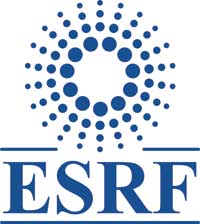
More than a quarter of all drugs work thanks to G-protein-coupled receptors (GPCRs). These proteins are embedded in the cell membrane and bind other molecules, relaying the signals conveyed by them through the membrane. This process often transmits sensory information or changes in the physiological state from one cell to another. The β1-adrenergic receptor, for example, is the GPCR relaying a signal conveyed by the release of adrenalin or related agonists into cells in a number of organs including the heart, where it leads to an increase of the heart rate, one of the most important body functions.
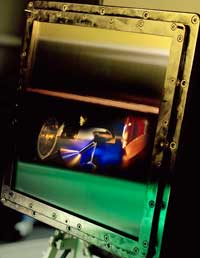
detector (background) on
ESRF beamline ID23, where
the GPCR protein structures
were determined
Image courtesy of P Ginter /
ESRF
Determining the structure and function of β1-adrenergic receptor could therefore help pharmaceutical companies to develop more efficient drugs. However, good crystals of these proteins are extremely difficult to make. With the help of micro-focus X-ray beams at the European Synchrotron Radiation Facility (ESRF), however, Tony Warne and colleagues from the MRC Laboratory of Molecular Biology in Cambridge, UK, were able to solve four structures of this receptor, bound to four different agonists. These structures enabled the researchers to identify the interactions that appear to be crucial in signal transmission.
To learn more, see the news article on the ESRF website (www.esrf.eu/news/general/GPCR-structure) and the research paper:
Warne T et al. (2011) The structural basis for agonist and partial agonist action on a β1-adrenergic receptor. Nature 469: 241–244. doi: 10.1038/nature09746
Download the article free of charge below, or subscribe to Nature today: www.nature.com/subscribe
To learn more about ESRF, see: www.esrf.eu
Resources
- The two cited Nature papers can be downloaded free of charge here:
- International Human Genome Sequencing Consortium (2001) Human genome. Nature 409: 860-921. doi: 10.1038/35057062.
- Download the article free of charge here, or subscribe to Nature today: www.nature.com/subscribe
- Warne T et al. (2011) The structural basis for agonist and partial agonist action on a β1-adrenergic receptor. Nature 469: 241–244. doi: 10.1038/nature09746
- Download the article free of charge here, or subscribe to Nature today: www.nature.com/subscribe
Institutions






